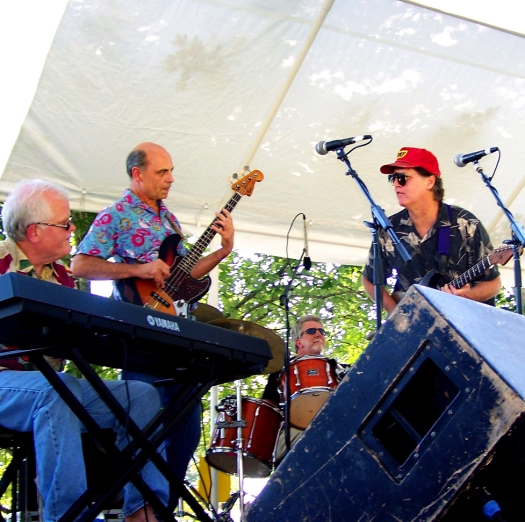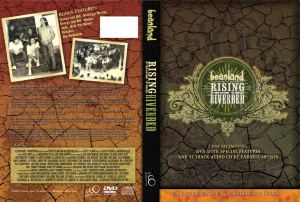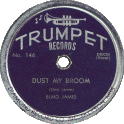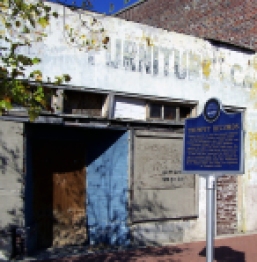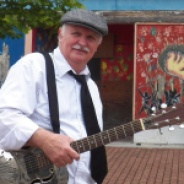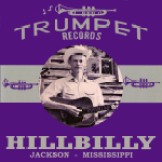Unforgettable to his contemporaries, a will-o’-the-wisp to others, Verell Pennington Ferguson III is often described as Mississippi’s first beatnik, a gleeful and strident nonconformist at Ole Miss and points beyond. V.P. Ferguson has become a legend to many, a status fully justified by his utmost legacy, Days of Yoknapatawpha, a “memoire/timeplay” written at the urging of a friend in the publishing business who told him to “Recall the old days, Faulkner still alive, and you managing the cultural life of Oxford with la main gauche while beating time with the other for your various and assorted bandsmen.”
The section reproduced here, entitled “7th Movement: Mose Allison and the Cool World: Ole Miss—1949-50”, describes V.P.’s first encounter with another legend, Mississippi jazzman Mose Allison, on the campus of the University of Mississippi on a winter’s day in 1949. It is only a fragment of an astounding manuscript, full of humor and insight and populated by some of the most famous people of mid-20th century Mississippi. Deepest and most profound thanks to artist, gentleman, and bon vivant Johnny Hayles for his perceptive, indefatigable research, considerate advice, and unmitigated generosity.
It was a lovely day in early January—at zero degrees centigrade—where a sun-filtered mist, breaking down at ground level, enshrouded the campus in a crisp, ashen whiteness. Shortly after lunch, about 14 hours, the Ole Miss Grill was overflowing with permanent grill-hounds, many of whom considered class attendance as secondary activity, if not outright torture, and of course the classic défilé of bewitching doe-eyed gazelles—and long-stemmed greyhounds.
The in-house jukebox was playing “Greeneyes” (“those cool and limpid”: Jimmy Dorsey, Bob Eberly and Helen O’Connell). Nobody could be unhappy around here, I reflected, as I duly parked the nervous little Ford in front, then wandering through the University Post Office for a quick mail check before floundering into some serious grill-hounding myself. Hardly inside and seated before cherished breaded veal cutlets with Roquefort, I was warmly heckled by “Fish” Salmon, the powerhouse quarterback, and Douglas “Little Abner” Hamley, a star linesman from Lake Charles, Louisiana, both inveterate Damon Runyon wits. “Yeah, that’s it, dad. Hang up the gloves, man, hang up the gloves! You’ll never make it, V.P. Ferguson!” (They were both right.)
Both faces gleefully pointed out a large black and white press photograph thumb-tacked onto the adjacent campus bulletin board before I sniffed out the source of my public shame. It was that jinxed photo again! Maybe the Tombigbee Sage was right after all: “People are no damn good!”, which, unfortunately, down in Columbus, hadn’t stopped the Sage, now the Hook, both of whom read the Memphis press, to roundly snigger at my latest public nemesis. The large, inopportune photo in question was untimely taken a short while back during the Golden Gloves Mid-South Tournament of Champions staged at Memphis, where, to say the least, I was engaged in a real “down-home slug-out”. The caption read: “Ole Miss’s V.P. Ferguson heads for a hard seat—before coming off the canvas to take a unanimous decision.” It was, and I did. Salmon and Hamley got all torn up. Mysteriously, someone even paid for my breaded veal cutlets.
However, feeling called upon to explain, I “thrusted home” like the grill-hound Cyrano that I was. “When that George T. Billy from Fort Smith, Arkansas pummeled me around my flat-topped head, I saw a grandiose colored flash, like a purple ball of fire, and ricocheted off the canvas. But without a count, mind you: a crew of cameramen flashed on me like I was the real Richard Widmark in a fast-paced, Grade B thriller: but when, in turn, I fire-stormed good old George T Billy to the canvas, at least twice, not a flash bulb went off. That’s the shabby popular press for you: but it couldn’t happen around here. You all ball-player grill-hounds are coming down with hamburger guilt, a Freudian jock strap transfer blaming the other goof folks whenever you “lose the big game”. In the Ole Miss/Quo Vadis/S.P.Q.R. show, none of you gladiator ball jocks are ever photographed all strung out on the ground, or worse, like poor fighters! Those AA/PR men around here are better paid than foreign agents!”
My lost dog act played out better than expected. Both Manley and Salmon invited to smuggle me into the jock strap steakhouse tonight for still another seared slab of fabulous Texas longhorn. The Richard Widmark act was not without merit, and grill-hounding had become an art. Abandoned at the corner side table for a quarter of an hour or so, I fondly reflected that outside of my romantic, geo-pantheistic idée fixe of canoeing down legendary waters, I entertained the lingering dream of creating another dance band. Not a big orchestra; the on-campus, well-rehearsed “Mississippians” were far beyond me for a class, but a high voltage jazz combo operating with about 6 or 7 Damon Runyon characters like myself—sunbelt hard cats living out the life adventure in rhythm, fervor, and soul. Leaving the table and the pulsating Ole Miss Grill, I had it: “The Let It Roll Band”—it was as sure as death and taxes.
Returning to the ’32 Ford Roadster, I adroitly placed a pair of powerful binoculars, canoe paddle, and a copy of Philip Wylie’s Generation of Vipers up behind the front seat. Having read the innovative intriguer, (The Mom, Apple Pie and Baseball Flap I was relieved to discover that among other bourgeois nightmares, I had happily escaped what Wylie allegedly described as The Dreadnaught Syndrome: there’s no good old Mom, the catalyzer of the All-American Square, in the new family Buick off to the supermarket to load up on more burger meat and tons of ketchup.
That was heady stuff, attacking good old Mom, burger meat and ketchup was tantamount to Jack the Ripper slashing Saturday Evening Post covers. Curiously enough however, seen from another angle, Wylie’s fevered, Freudian, matriarchal fiasco humorously backed into certain of my reflections concerning good old George, and Miss Milly T. Billy, the archetypical bird-brain hicks. But intellectual macho was already démodé, if not effete, and Wylie might be heading for unnerving trouble with the ladies, including a new race known abouts as “Jane the Beards” pulling on line from corporate board rooms to backwater togetherness. As for the common man’s Richard Widmark, I liked Philip Wylie, apple pie and baseball. As for good ole Mom, whom I had nothing against, end even visited on occasion, she dutifully machined through the University of Virginia Law School at Charlottesville, as did my sister Betty, belatedly becoming an excellent professor of commercial law in that elegant state, but my existential good taste remained beyond reproach: I was raised by the Wizard and “belonged to Ole Miss”.
Once the daydream drifted off, I leisurely opened up the small rumble seat on the fast back, fumbling around with some unread novels, river maps and assorted outdoor gear when I saw it: the vast spinach greenness wearing Tallahatchie County license plates—kept coming and coming, finally docking beside my modest little ’32 Ford Roadster, imposing as it were through the sun-filtered, ashen whiteness. I saw that all of that long greenness belonged to the latest model Chrysler New Yorker—a veritable limousine de ville: the driver, flashing a generous smile, sprang out as if he was making a homecoming landfall. (He was.) If the eyes were the windows of the soul, the stranger, looking out on the world in blue electric, extolled instant intelligence.
And there he was, an authentic sunbelt hard cat of medium build, cinnamon hair worn in a brush, a classic, sensitive face, and moreover, decked out in cool, California/Vegas togs: Bordeaux red cardigan, with polished brass buttons, snug-cut butter yellow shirt with oversized buttoned-up collar, worn over full rich lemon trousers, a hand-crafted Aztec beaded belt, and ankle-length high desert boots. While the long spinach greenness had little in common with the California Special, there was, however, an irrefutable linkage to the Damon Runyon world, as I reflected for an instant that we both solicited the same mail-order West Coast tailor. But it was an illusion. Upon second glance I realized that the unknown creature momentarily appreciating my roadster was hardly inspired by hip advertisements in hot rod magazines. While flashing the same “Culver City style”, his “threads” were obviously more refined, and several cuts above mine.
As usual, my Richard Widmark act was spontaneous: “Man, with a cruiser like that, you must need a harbor pilot! But the next time you cool in with all that lovely greenness, please extend me the grace of not docking alongside my little ’32 Ford. You make me insignificant.” The colorful character fleeing across the street toward the Vardaman-Longstreet dormitory complex flung an arm high in the air: “Don’t panic, dad! Energy of that class commands a lot of respect!”
Room address in a suede gloved hand, I, in turn, wandered across Grill Street to the Vardaman-Longstreet in hopes of ferreting out a few high tension elements for the on-coming “Let It Roll Band”. Although someone said “third floor right”, it was irrelevant—I picked up on the solid jazz sounds even before entering the building. Arriving at the moment of truth, I peered through the half-opened doorway into a blue-bulbed inner sanctum at what was surely the cutting edge on the cutting edge, where six or eight sunbelt hard cats, all dressed in California/Vegas togs, were solemnly planted around a scratchy record player listening to hardcore bebop. I rapidly spooked out the pilot of the long spinach greenness, a proselytizer, if not a high priest of la nouvelle vague (New Wave jazz). I hesitated a moment until he recognized me, smiled and waved me into the inner sanctum, where, by happenstance, I entered into a new dimension. That simple gesture, although coming from the same Damon Runyon world, portended a certain esoterical attitude, engendering, as it were, a colorful lifestyle of its own. I was altogether intrigued.
The stranger was called Mose Allison, Junior, from Tippo, Mississippi, a lovely, lost corner in fecund Tallahatchie County, where he was raised in an affluent plantation family. Upon first contact, however, in front of the Old Miss Grill, by the strange mystique of instant enlightenment, I somehow realized that Allison was world class talent, (I was not wrong) and indeed honored to have made a brilliant new friend. The comfortable, blue-bulbed dormitory room, spatially limited, cluttered and strewn out pell-mell with the banalities of quotidian existence, took on the allure of an urban ritual where bohemian characters from the 4th dimension gathered around a record player instead of a fire, listening, as it were, to fascinating far out new sounds.
When the frenetic record, re-played several times, finally ended, Allison, ardently searching for another in the stack, paused, and looking up with a smile, announced my modest entrée to no one in particular: “Ah! It’s the California Special back on the scene: We were listening to Dizzy Gillespie’s “Things to Come”. Did you pick up on it, dad?” I was at ease. My Damon Runyon background was well anchored: “Oh yeah. That’s frantic stuff, man! But outside of my collection of Stan Kenton and Herman’s Jimmy Giuffre thing, “Four Brothers”, sadly enough, I don’t know a lot about New Wave jazz.” Someone on the far side of Allison allowed as to how it was called bebop.
“Sure. Yeah, man, I know, the image is colorful enough, but somehow obscure. At any rate, let’s face it New Wave jazz has outgrown show business. In fact, it’s no longer dancefloor stuff. It’s moved into the concert hall where it really belongs.” Concluding my rather off-hand reflection, the relative silence rippling across the blue-lighted little room of sunbelt hard cats was my no means an admonishment, but rather heralded a warm, on the spot friendship which was to endure for years, or as it were, if Mose Allison was an ace proselytizer and high priest of New Wave jazz, seen from a certain angle, I was a defending knight, or an engagé as the French would have it.
Among the six or eight, there was Bill “Big Jay” Katz (after Big Jay McNeely, “Deacon’s Hop”-1948, etc.), a hard-driving tenor saxophone player from New York City tall, well-groomed with burnt, desert sand hair, matching eyes and a disarming, soft-glowing smile. John Earn MacDade, a hip, bushy-haired ace Mississippi trombone veteran—and blithe spirit, avoiding all physical effort whenever possible, championed the “L.A. hard look” and could have just wandered off Hollywood and Vine in a lime green cardigan, tomato red shirt with oversized, buttoned-up collar, worn over pleated, black velvet slacks and Aztec moccasins. Thomas “Bunky” Lane was a romantic, slender-built mystic with raven-hazel hair worn in a tall bush cut, whose sensitive, near melancholic face and deep chestnut eyes reflected the inner fire of an introverted intellectual. Lane, an ethereal alto saxophone player and biology major, normally dressed in black or blue double-breasted suits and dark Windsor ties, possessed the ultimate, if not indefinable talent: a musician’s musician, playing New Wave jazz with a relaxed, full-blown richness inspired by the beguiling tenor sax, Stan Getz (“Early Autumn” with Woody Herman-1948), Lennie Tristano, Dave Brubeck, and the Modern Jazz Quartet, Lane, “The Mystic” readily measured up to any avant-garde, mastering a style which had just begun to be called “Cool Jazz” (1948-55).
As for the creative brilliance of Mose Allison, Jr., out in the surrealist world of good ole George T. Billy, amid a myriad of bucolic squares, he was light years ahead of the scene, ,and moreover, he knew it. But for the ongoing moment, however, he allowed as to his recent Tallahatchie county homecoming: “I was discharged from the army a short while back, where I was in training with special ski troops out in Colorado Springs, the fabulous Far West—real Nirvana! But I picked up all those hip threads in Denver, man, a mountain paradise a mile above sea level. Someday I’ll make that scene again!”
Suddenly John MacDade (Hollywood and Vine) and “Big Jay” Katz got all torn up, which apparently had little to do with Allison’s hip Denver togs. By the time Lane “The Mystic” chimed in, I knew in my bones what was coming. (It did.) “Say, Man, aren’t you the fighter cat in that action photo over at the campus grill?”; “Yeah, man, the one where Widmark is going through the ropes, head first!”; “Yeah, man, he’s the cat. The whole campus has spooked that photo. In your case I would either sign it, or take it down! You’re playing out a no win scene, man!” Somehow I was happy, if not mollified. “A good sense of humor was the escape valve of humanity.” Good musicians were my chosen people, an idée fixe—happily following me into old age.
“Okay, you cats! So I suffered an inglorious scuffle—but I don’t plan to make a lifetime of it! In fact, that purple ball of fire convinced me how right I was to take up the slide trombone. It’s easier on the jaw!” The scene shifted into another direction as Mose Allison spooked out an amusing intruder. “It’s Mister Coffee Nerves—the phantom nerve ball of the corridors! Coming to rain on all the hard cats about all this degenerate bebop music!
Allison, possessing a spark-jumping, electric wit, apparently enjoyed riding super-squares like Mister Coffee Nerves, distant outsiders going far beyond mere Squaredom into an anti-bourgeois dimension, which seen from a certain point of view, was a negative form of hip. Mister Coffee Nerves, ostensibly a precursor to Sal Mineo (Plato in Rebel Without a Cause) dressed in impeccable buttoned-up tweeds, gave the impression of tortured precocity: a chubby, cherub-faced little enigma, with the pink, stubby fingers of a child strangler, and who had been thrown out of an impressive number of tony prep schools on strange and obscure charges, including “ghoulism”, whatever that entails. Mister Coffee Nerves professed to being a self-styled nerve grater, sand papering the nerve endings of even the most comatose victims with astonishing success. Flashing his dead fish smile, Mister Coffee Nerves entered the inner sanctum with customary flair: “Gentlemen: or should I more fashionably say “sunbelt hard cats”? I suppose that all of this bebop monkey music has softened your brains: it was inevitable.”
Mister Coffee Nerves, pausing for effect, lit up a super perfumed, long, rainbow-colored cigarette and gleefully moved into action. “Perhaps you should like to receive with me some good old “down home” Dixieland. Why not Louis Armstrong? Yes, that’s it. “When the Saints Go Marching In”! Good for the soul, you know, and a bit of Doris Day. Good, bitter-sweet for broken hearts. And of course Harry James. That “crying trumpet”! Ah! A good ole circus man, Harry! Gentlemen, excuse me, I mean hard cats, this decadent bebop can only lead to catatonic schizophrenia, or worse! You had better repent and go back to ragtime! Rudy Vallée is great!”
The super square had talent. Nobody could be that outrageous by happenstance; one had to work on it, which he did. The triggered ubiquitous reaction readily proved that point, nearly driving MacDade, H&V and Big Jay Katz, among others, up the walls. Coffee Nerves listened on in ecstasy. “Most of those old-style cats were greatmechanics, man, but they played themselves into a dead end!”; “You’re cool, dad. That “crying trumpet” cat plays good B.C. (*Before Christ) horn, but in A.D. (*After Dizzy) he sounds like he’s changing a flat tire!”; “You’re a hard can, man! And that D.D. chick (*Doris Day) sings like a melting river of chocolate at the Lonely Hearts Club!”
Mister Coffee Nerves, fawning over a certain Pavlovian success, fired up another rainbow-colored cigarette, and came up with his best dead fish smile ever, although somewhat askew, on the spot; one wondered how a lone cigarette could be charged with so much perfume. Shortly thereafter, Mister Coffee Nerves, freezing on the dead fish smile, took leave of the bebop inner sanctum, as usual, in super-square flair. “Well, gentlemen, if you’re please excuse me, as those “hipsters” say down in good old rockabilly, ‘See you laters, alligators!’” Pulling hard on the rainbow-colored cigarette, the chubby, cherub wandered off down the corridor to bug a couple of itinerant Jehovah Witnesses passing through to save Ole Miss from abject heresy and assorted Devils. But destiny can be cruel even for fevered missionaries, Mister Coffee Nerves would see to that. In the worst case scenario, the naïve zealots, disillusioned, would certainly be losing face, if not faith.
Back in the inner sanctum, where even the ace proselytizer was a bit slack-jawed, the sunbelt hard cats returned to normal, playing “Night in Tunisia”, “Manteca” (Dizzy G.) and “The Chase” (Wardell Gray/Dexter Gordon) not without a last reflection: “Man, I fell you, that Mister Coffee Nerves is really a twisted little cat!”; “Aw, yeah, dad, he’s warped 360 degrees! And there’s no exit!”; “Yeah, man, coffee nerves is all strung out with an eerie talent for negative genius!”














